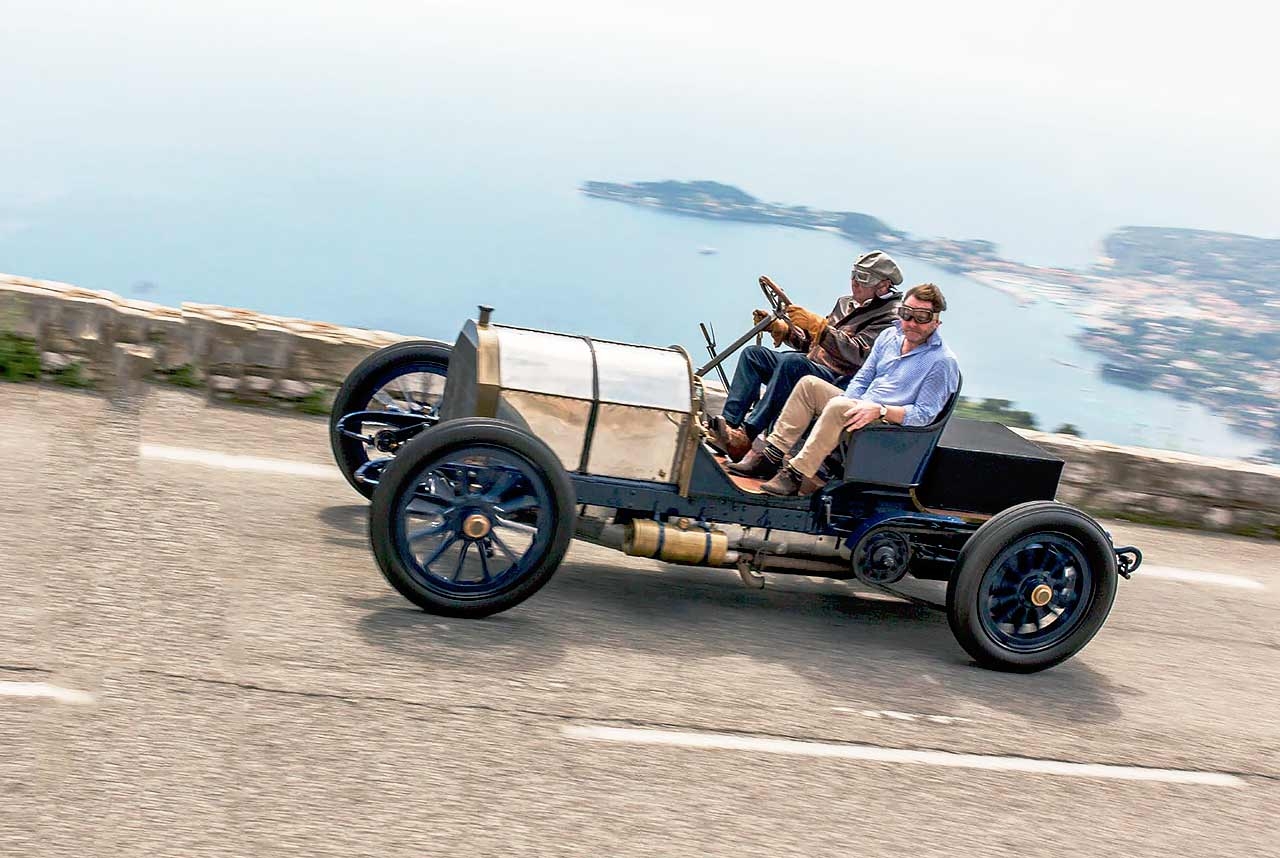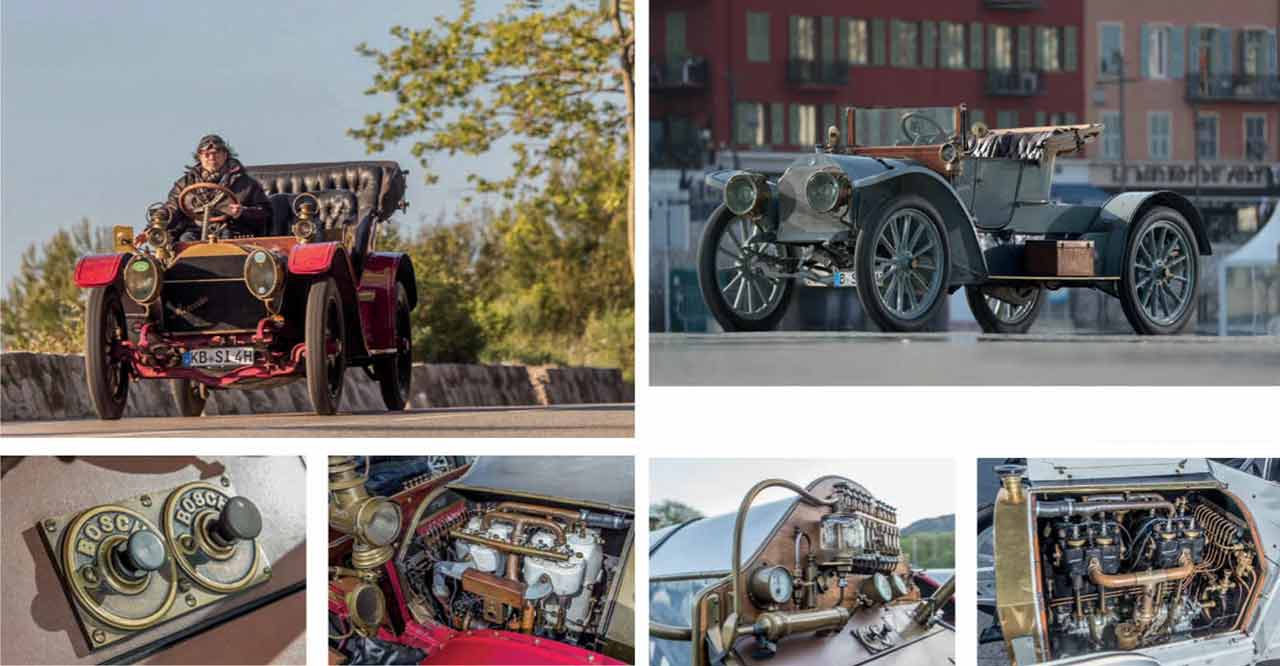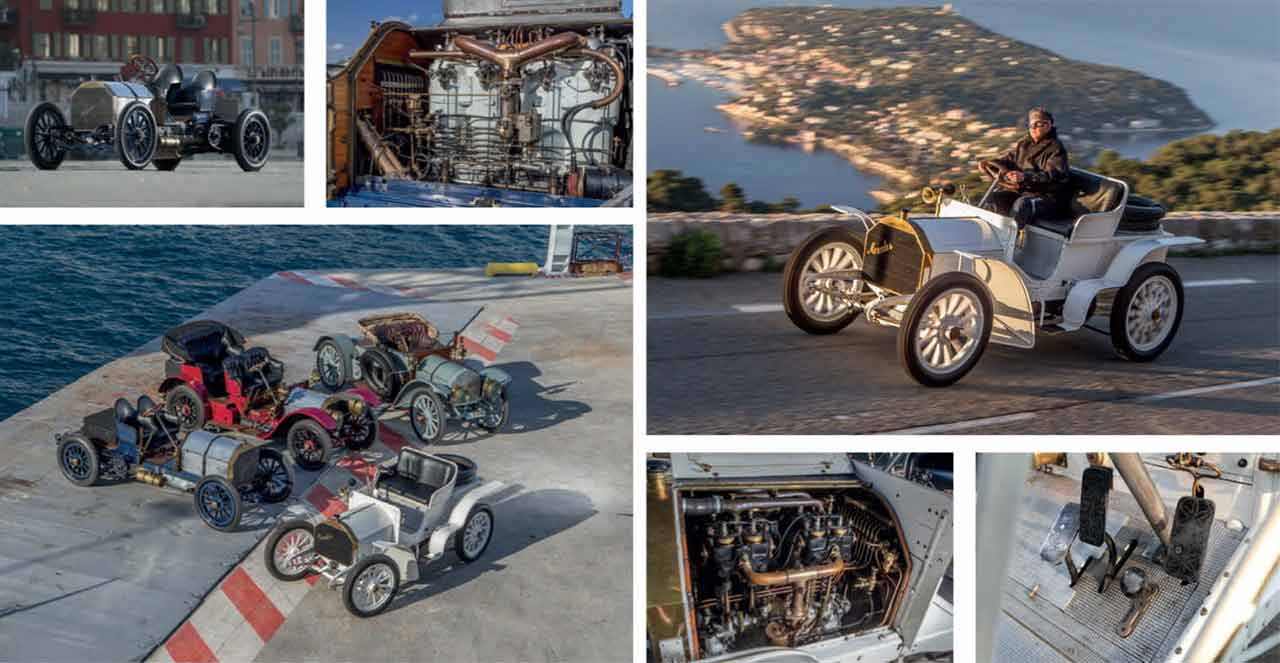
Mercedes’ amazing Riviera reunion. C&SC hits the Côte d’Azur to mark 115 years of Mercedes. Mercedes: the origin of the species. The French city of Nice is almost as crucial in Benz history as Stuttgart itself. James Elliott has a hairraising time finding out why. Photography Mercedes-Benz Classic.
Simplex centenary Celebrating 115 years of the name aboard the chain-drive Mercedes.
Jochen Mass is in his element, refusing to allow his pulse to quicken even in a situation of high drama. Just minutes after calmly quoting Rudyard Kipling’s From Sea to Sea… the German who triumphed at Montjuïc in 1975 – and subsequently became a mainstay in endurance racing – is sliding a 1903 Mercedes 60hp around a blind corner on the treacherous Corniche. Half a metre to his right – on tall 12-spoke carriage wheels, just a brief hop over a low wall that appears more like a high kerb – is a 300ft drop into the Med, to his left is a terrified passenger, perched upright and hanging on for grim death as he slithers across the seat, sweaty palms threatening to loosen his grip for him. A maniacal grin spreads across Mass’ face and fixes itself as his eyes narrow and he attacks ‘La Turbie’. He then yanks on the handbrake to retard this impressive, grunting German nine and a half litre machine, dismissing the transmission- based footbrake as “ineffective” at hauling it up. He is revelling in the car, its tractability and its bucketload of torque. “This is what a car is meant to be,” he shouts over it. “The steering is heavy, but otherwise it is like driving any car.”

And that is the point that the Daimler group is trying to make in arranging a unique gathering on the French Riviera, 115 years after the name Mercedes first officially appeared as a brand of car in its own right – that its remarkable 35hp, 40hp and 60hp deserve to be recognised as the first proper cars. It has a decent shout, too, if you consider what came before, and that these vehicles established the template of a single design with a multitude of applications – different bodies, engines and wheelbases transforming it from all-conquering racer to practical workhorse to luxury tourer. That concept and the brilliance with which it was executed mean that few, if any cars have rewritten the rulebook as comprehensively as the Mercedes-Simplex.
The Simplex, as it was known from 1902 to 1905, had been conceived for Daimler – as was its predecessor, the template-setting 5913cc short-stroke 35hp – by Wilhelm Maybach in Stuttgart. It was dubbed Simplex because of both the way it rationalised existing operating procedures and offered simplicity of getting anywhere via high levels of comfort. Longest lasting was the 6785cc 40hp, which was introduced in 1902 and developed annually until being discontinued in 1910, while shorter-lived versions of the initial variants were the 28hp (21/35) and 20hp. The following year, Maybach introduced the defining overhead-valve single-cam 60hp range, which, with displacement of 9235cc thanks to enlarged bores, had 60hp at 1600rpm.
Technologically, they innovated via overengineering, bringing simplicity and reliability, plus power to the car. Nothing else combined all the available science at that time in one car, and the Simplex became both the birth of what we refer to as “German engineering” and the death of steam and electric motive power.
The keystones were a light, powerful engine (made of magnesium-aluminium alloy) fed by Maybach’s own spray-nozzle carburettor and low-slung behind the front axle in a long wheelbase for a low centre of gravity, with a honeycomb radiator designed into the car’s nose. The gathered cars have many points to make: the genius and purity of the concept, its place in Mercedes-Benz and motoring history, plus the success of its myriad applications.

28/32 was supplied by a private owner and, although less powerful, is supremely comfortable with plenty of space for four people on board. Clockwise from top left: twin Bosch magnetos on 60hp racer; ignition contacts on 28/32; 40hp has single Magneto, 45hp boasts long wheelbase.
But why Nice? Well France’s fifth largest city was home to Emil Jellinek, the man who gave his daughter’s name to what had previously been Daimler. From the showroom in his villa on the Promenade des Anglais Jellinek sold a disproportionate number of the company’s cars, giving him huge power and influence in Stuttgart. A gifted marketer, it was he – driven by his customers – who governed the direction the company should take. As a result, if Maybach was the engineering genius behind the birth of Mercedes, then Jellinek was the visionary who inspired the company to make the transition from horseless carriage to motor car. But the Riviera was more than just where the cars were devised and sold, it was also where they were proven, by destroying all opposition on the epic LaTurbie hillclimb.
Which is where Mass comes in, and he is taking no prisoners. With just four cylinders yet more than nine litres capacity, you can almost imagine those dustbin-sized pistons thrusting in slow motion like the unstoppable force of a hydraulic press. “I love the car, but you need to plan ahead,” says its pilot as he changes down through the four-speed ’box and the two vast chains tug harder still on the rear axle to propel less than a tonne of racer. “Because you use the handbrake to slow it, you must take it out of gear to keep momentum, but other than that there are no headaches. There is tremendous torque and it changed people’s ideas of what a car could be – the Simplex was the first modern car.”
Scottish F1 ace David Coulthard is rather less gung-ho. The Monaco-based ex-racer, who confesses that he is a disappointment to his family because he is the only one who does not hold an HGV licence, is at the wheel of Daimler’s own 1903 40hp, one of the oldest-surviving cars to bear the Mercedes name. “I don’t think I have driven anything this old before,” he says. “I’ve tested most of the Silver Arrows and enjoyed that experience, and this one is similar if a bit more leisurely. It is a very different sensation sitting on top of the car instead of in it and that makes you aware of your vulnerability, but there is that same connection with the car that has been eroded over time. The driving experience is fine because it does everything you expect it to except centre the steering wheel. It helps that I am familiar with the road!”

You may not have heard of the man in charge of the other two cars – a 1904 28/32hp and a wonderfully patinated 1910 45hp – but he is one of the luckiest motorists in the world. Having joined Daimler in the 1980s, Michael Plag is now in charge of all the company’s pre-war cars (oh, and the Gullwings, too) and no one is more experienced in driving them. He says: “These cars really were revolutionary when they were new, the 60hp was the supercar of its day, but for me the others were just as important historically because they also took the concept of the motor car in new directions. You don’t expect a tourer to drive like the sports car or the racer, but they are all superb at what they were designed for.”
For example, the 45hp dwarfs the 60hp with its long wheelbase and tall body complete with dicky seat. It’s also at least half a tonne heavier, but then it was built for Argentina where it was expected to cover huge distances on primitive roads. Thanks to an 80-litre tank, it has a 300km range and would canter that distance in the height of luxury, one of its four pedals even operating the wildlife-scattering horn.
The short-wheelbase 40hp falls somewhere between the two, having a top speed of 111kph compared to the 45hp’s 80kph and the 140 achieved by the 60hp with its hot camshaft, Maybach race carburettor and twin magnetos. If you had to pick one for everyday use, this would probably be it. Slowest of the quartet is the 65kph 28/32 on a low-voltage magneto system with ignition contacts rather than plugs, but this model was the most successful sales-wise.
So four very different cars built on a single foundation. Such versatility is the true gift of combining Maybach’s engineering and Jellinek’s vision. There have been many stepchanges in motoring, but it is difficult to think of one so huge as the introduction of these Mercedes. And that’s why those years at the start of the 20th century were called ‘the Mercedes era’.
Mercedes’ French Connection
Nice’s explosion onto ‘the scene’ took place in the 19th century, led by Queen Victoria who popularised it as a British holiday resort rather than a fishing village. Then part of Savoy it became French in 1860 and joined the rail network four years later, its visitors eventually turning their attention to summer and the sea having had previously gone there for winter and the mountains (the entrances of all the older, grander hotels face inland). Europe’s elite gathered in this playground for months on end, not just the likes of Emil Jellinek and his family – who commandeered an entire train to get there from his villa in Baden, Austria – but branches of the Rothschilds and many more.
Having been born in Leipzig in 1853, Jellinek was already wealthy via tobacco and insurance when he moved to Nice in the 1890s and lived there until 1914 before dying in Geneva in 1918. It was a natural place for the diplomat to the region to sell his cars – you can imagine the sensation they would have been amid the horses and carriages on the Promenade in 1898 – from a showroom at his villa.
In a nascent version of race on Sunday and sell on Monday, he set about using them to dominate the Nice Week via his Mercedes team. Indeed, his first sale was a 35hp that in race spec and driven by Wilhelm Maybach won the sprint and then was instantly sold on to Henri de Rothschild in road trim. Jellinek’s importance to Daimler was huge – in 1900 he sold 72 cars, 60% of all production – and, as a result, so was his influence. His marketing brain and Maybach’s engineering prowess were the cornerstones on which the company was built, but both left in 1907 when new management meant waning influence for both men.
So what of the name? Every one knows now that ‘Mercedes’ (which is Spanish by derivation) came from the Emil Jellinek’s 11-year-old daughter, who ironically never drove, but that shouldn’t be a surprise because he called everything Mercedes, from his various homes to all his yachts. From 1903, he even adopted it himself to become Jellinek-Mercédès.
It also forms his legacy in Nice, with roads and blocks of apartments still bearing the Mercédès name. As a result, there are signs of Jellinek’s presence all over the town and the family tomb/mausoleum holds a prominent position on the upper (therefore most important) tier in the graveyard with its spectacular views over the city.

Flamboyant Jellinek aboard his 16hp Daimler in 1899
Nice week and the La Turbie
At the dawn of the 20th century, for a week each year Nice became the epicentre of the motoring world. There were events along the Promenade des Anglais, 400km endurance races and more, attracting early hotshoes such as Camille Jenatzy. The showpiece was the La Turbie hillclimb, however, originally a 17km trail from the Riviera town up to a village on the Corniche via Raphaël Bischoffsheim’s famous 1879 observatory. La Turbie is now most familiar for being the scene of Princess Grace’s fatal 1982 accident and as a location in Ronin, but it became active in motorsport in 1897 and carried on sporadically until almost WW2, decades after NiceWeek had disappeared.
Emil Jellinek ran a 12hp Daimler in its first year, entered Arthur de Rothschild on a Daimler Phoenix in 1899, and in 1901 his 35hp Mercedes cleaned up in the hands of Wilhelm Werner. The success was repeated in 1902 with ET Stead winning La Turbie as 40hp cars swept the podium, while Otto Hieronimus and Wilhelm Werner took the top two spots in 1903. Early fatalities included Count Elliott Zborowski, father of Brooklands racer Louis, and Wilhelm Bauer, both of whom perished on the first corner (in 1903 and 1900 respectively). After Zborowski’s death, La Turbie was dormant until it was revived as a 9km course in 1909 and by 1936 the record on a further shortened route was held by Hans Stuck, who blasted his Auto Union up the hill in just 3 mins and 39 secs.

Baron Pierre de Caters on La Turbie in a 60hp in 1903





